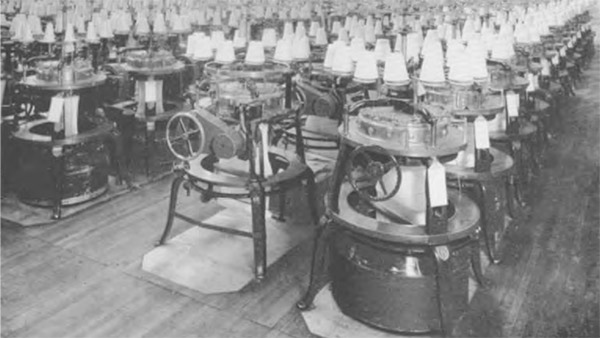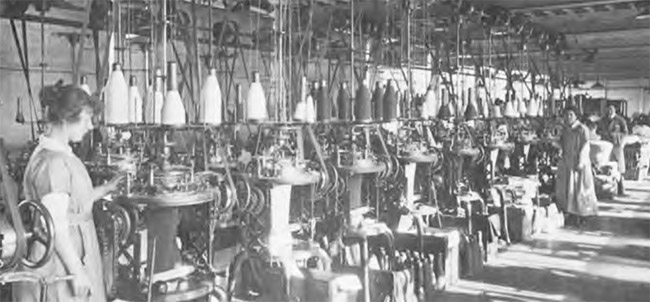THERE IS A WEALTH OF INDUSTRIAL HISTORY HOUSED WITHIN LEICESTER, AS PUKAAR MAGAZINE ExPLORES HOW ONE OF THE MOST SIGNIFICANT TRADES IN THE WORLD FOUND ITS FEET IN OUR VERY OWN CITY.

enormous contribution to the economic state of Leicester, as well as providing jobs and a wealth of culture, for hundreds of years. It has become integral to Leicestershire’s identity, so much so that the county’s coat of arms features a sheep in recognition of the prevalent wool usage in its hosiery manufacturing.
The hosiery trade, historically at the centre of Leicester’s entire textile industry, is said to have begun when the first stocking-frame was brought to Hinckley in 1640 by William Iliffe. By 1844, there was an estimated 18,494 working frames in the city which outweighed surrounding areas such as Nottingham and Birmingham in their hosiery production. Specializing in wool, the success of the industry lay mainly in its refusal of turning to steam powered factory production. Whilst most other textile industries had made the switch, Leicester kept up its most-preferred hand-frame method of production.
However the prosperity which the industry was enjoying was not to last forever and 1845 saw the beginning of its decline. Due to a waning in foreign trade, hosiery production had been significantly reduced and in as little as twenty years there was a 20% reduction in hosiery exportation. By the middle of the 19th century the industry, which had seen Leicester’s economy flourish, soon felt the force of manufacturing problems. The preferred production methods had become outdated and overcrowding in the sector meant manufacturers had lost control of the market.
It was the decision to educate the young in textile production which began to breathe life into the industry. In 1885, championed by the Chamber of Commerce, Wyggeston Boys’ School began providing classes on hosiery which were the first of their kind in the country. Over seventy years later the lessons in hosiery manufacture and design still existed, when in 1955 classes started
being taken by local manufacturers, who were essentially training their future employees.
This education of textiles and the design industry has since grown stronger and is now more popular than ever. Leicester College houses a range of courses from Fashion Costume Foundation degrees to Pattern Cutting and Garment Construction, whilst De Montfort University is at the forefront of fashion design with its Fashion and Contour Design course being a leading creative department for female underwear, not to mention busy designing shoes fit for a Princess. De Montfort Graduate Becka Hunt, who studied Footwear Design, was honoured in 2012 by Duchess of Cambridge Kate Middleton who chose her shoe design as her favourite amongst 120 students. Clearly the industry in this region is still alive and well and thanks to such recognition of upcoming talent, sure to transcend globally.
One of Leicester’s most notable textile manufacturers is the hosiery firm Corah, founded by Nathaniel Corah in 1815. Whilst he initially undertook manufacturing at his farm, Nathaniel soon moved into buying ready-made stockings in order to sell at a profit. This business model allowed the company to prosper and by 1824 they were able to purchase their own premises on Union Street. Whilst Corah were successfully holding their weight in the industry, it was the partnership with Marks and Spencer which propelled them into their iconic status. In 1926, Corah inspired the creation of Marks and Spencer’ luxury ‘St Michael’ range which meant longer, more profitable production runs were now in place and the manufacturing of high-quality products were well underway. This working relationship lasted until 2000, having had a design room at Marks and Spencer’s until the 1960s and celebrating a trade worth £20 million per annum in the 1970s.
 From the beginning of the 1940s the industry as a whole was definitely one of growth, with 71 million hosiery products being produced in the UK alone. Higher standards of living amongst Leicester citizens, teamed with a reduction in patching and darning one’s own clothes, meant that the demand for hosiery was high and reduced production costs. This surge in product demand meant that there were now over 200 hosiery firms in Leicester and 33,310 people employed within them. However this prosperity of traditional factories was to become unsteady in later years. The 1960s and 70s bought about a decline in traditional manufacturing industries as new businesses swept in overtaking older, local factories and with a significant proportion of the traditional textile factories being moved overseas, the global industry grew from strength to strength.
From the beginning of the 1940s the industry as a whole was definitely one of growth, with 71 million hosiery products being produced in the UK alone. Higher standards of living amongst Leicester citizens, teamed with a reduction in patching and darning one’s own clothes, meant that the demand for hosiery was high and reduced production costs. This surge in product demand meant that there were now over 200 hosiery firms in Leicester and 33,310 people employed within them. However this prosperity of traditional factories was to become unsteady in later years. The 1960s and 70s bought about a decline in traditional manufacturing industries as new businesses swept in overtaking older, local factories and with a significant proportion of the traditional textile factories being moved overseas, the global industry grew from strength to strength.
Currently the worldwide textile industry makes up 8% of global trade in manufactured goods and generates over £260 billion in global exports. With the proportion of manufacturing now taking place in countries such as Bangladesh and Cambodia, Leicester’s resurgence of its staple industry has meant that instead of selling to the majority; they are able to focus on producing speciality textiles and high quality clothing which are sold globally. Sock producers Pantherella, based just off Saffron Lane, have their products stocked in high-end department stores around the world including Selfridges, Harrods and Nordstrom. Chief Executive, Justin Hall says “Leicester has a reputation of being an area of technical expertise and luxury. We’ve gained a reputation through decades as a high quality manufacture. There are a lot of niche manufacturers who serve niche markets and our market is a niche market.”
The industry has grown in cultural ways too with both traditional and contemporary fashion trends from India, Japan and South Korea being created and sold at Saree Mandir; the first established saree business on Belgrave Road, opening in 1963. Director Anil Khandelwal says there’s been a major change in the industry from when they first opened to today. “Historically Leicester’s been a centre for hosiery, but it has lost a lot of manufacturers like Corah who provided a lot of employment for people. It’s gone from manufacture to import but Leicester has been the centre for textiles.”
Whilst the manufacturing industry may have moved elsewhere, the textile design business is very much still thriving in the city, as global clothing brands like Next and George at Asda have their design centres in Leicestershire proving that the county’s textile history is truly alive and nourishes present design talent.
Leicester’s most significant industry is one of creativity and constant evolution. With a large proportion of factories peppered amongst familiar city landmarks, it may not always be obvious but the textile industry is still a large part of Leicestershire’s culture today and one that we are undoubtedly proud of.





